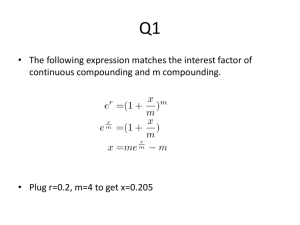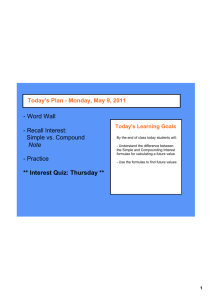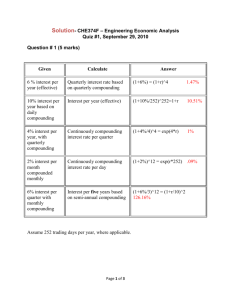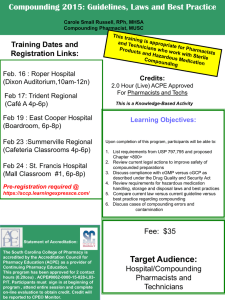Chapter08
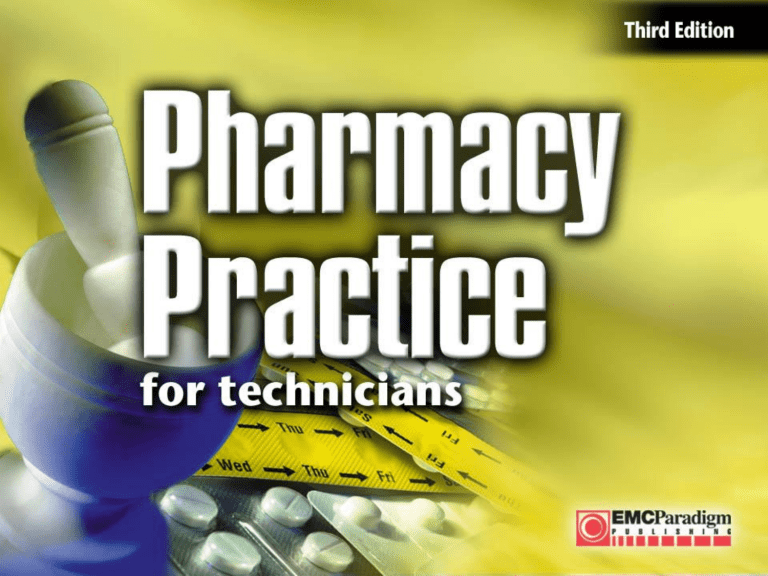
Chapter 8
Extemporaneous
Compounding
Learning Objectives
• Define the term extemporaneous compounding, and describe common situations in which compounding is required.
• Identify and describe the equipment used for the weighing, measuring, and compounding of pharmaceuticals.
• Use the proper technique for weighing pharmaceutical ingredients.
• Use the proper technique for measuring liquid volumes.
Learning Objectives
• Define the term percentage of error.
• Explain the common methods used for comminution and blending of pharmaceutical ingredients.
• Explain the use of the geometric dilution method.
• Explain the process by which solutions, suspensions, ointments, creams, powders, suppositories, and capsules are prepared.
NEED FOR EXTEMPORANEOUS
COMPOUNDING
Compounding might involve mixing a powdered active ingredient with a diluent powder and filling a given number of capsules with the combined materials.
Compounding Issues
Safety Note!
• Products compounded for veterinary use cannot be used in humans.
Terms to Remember
• extemporaneous compounding
• good manufacturing practice (GMP)
EQUIPMENT FOR WEIGHING, MEASURING,
AND COMPOUNDING
•
Balances: Balance measurements using a counterbalance are made using sets of standardized pharmaceutical weights. An electronic balance is easier to learn and use and is more accurate than other types of balances.
•
Forceps and Spatulas: Forceps should be used when picking up weights so that moisture and oils are not transferred to the weights.
Spatulas are used in compounding tasks such as preparing ointments and creams or loosening material from the surfaces of a mortar and pestle.
EQUIPMENT FOR WEIGHING, MEASURING,
AND COMPOUNDING
•
Compounding Slab: This is an ideal surface for mixing compounds because of its nonabsorbent surface.
•
Mortar and Pestle: The coarser the surface of the mortar and pestle, the finer the triturating, or grinding, that can be done.
•
Graduates and Pipettes: Graduates come in two varieties: conical and cylindrical. A pipette is used for measuring liquids with a volume less than
1.5 mL
EQUIPMENT FOR WEIGHING, MEASURING,
AND COMPOUNDING
•
Master Formula Sheet: Prepared by the pharmacist, this sheet indicates the amount of each ingredient needed, lists the procedures to follow, and provides the labeling instructions.
TECHNIQUE FOR WEIGHING
PHARMACEUTICAL INGREDIENTS
Weighing of the product is one of the most essential parts of the compounding process.
Weighing the exact amount prescribed is essential in compounds for several reasons: the product cannot be “checked” for content once mixed, the quantities weighed out are often very small, and a slight overage could mean a serious overdose for the patient.
Figure 8.1
Figure 8.2
Weighing Pharmaceutical
Ingredients
1. Unlock the balance and confirm that it is leveled, front to back and side to side, using the leveling screws at its base. Once this is done, the balance is ready to use. Lock the balance once again, before transferring weight to it.
Table 8.1
Weighing Pharmaceutical
Ingredients
2. Place weighing papers on the two pans of the balance. These papers should be of exactly the same size and weight. The edges of the paper on the left-hand pan may be folded upward, to hold the substance to be weighed.
Do not place any materials on the weighing pans without using weighing papers.
Table 8.1
Weighing Pharmaceutical
Ingredients
3. Unlock the balance to confirm that the balance is still leveled, and then lock it again.
Table 8.1
Weighing Pharmaceutical
Ingredients
4. Add the desired weight to the right-hand pan, using forceps to transfer the weight from the weight container.
Table 8.1
Weighing Pharmaceutical
Ingredients
5. Place an approximate amount of the material to be weighed onto the left-hand pan, using a spatula to transfer it.
Table 8.1
Weighing Pharmaceutical
Ingredients
6. Slowly release the beam using the unlocking device at the front of the balance, and check the balance.
Table 8.1
Weighing Pharmaceutical
Ingredients
7. If the amount of the substance being weighed is too great or too small, lock the balance again and use a spatula to add or remove material (Figure 8.2a)
Table 8.1
Weighing Pharmaceutical
Ingredients
8. Slowly release the beam using the unlocking device and check for equilibrium.
Table 8.1
Weighing Pharmaceutical
Ingredients
9. Once a nearly precise amount of material has been transferred to the pan, a very small adjustment upward can be made by placing a small amount of material on the spatula, holding the spatula over the left pan, and lightly tapping the spatula with the forefinger to knock a bit of the substance onto the pan.
This is done with the balance unlocked and the balance beam free to move.
Table 8.1
Weighing Pharmaceutical
Ingredients
10. Lock the balance, close the lid, and then unlock the balance to make a final measurement. (At this point, have the pharmacist check the measurement.) (Figure
8.2b)
Table 8.1
Weighing Pharmaceutical
Ingredients
11. Lock the balance before removing the measured substance. Use transfer forceps to remove the weights and return them to their storage case.
Table 8.1
Terms to Remember
• Class III prescription balance
• counterbalance
• spatulas
• forceps
• compounding slab
• mortar and pestle
• pipette
• graduates
• master formula sheet
TECHNIQUE FOR MEASURING LIQUID
VOLUMES
A general rule of thumb is to always select the device that will give you the most accurate volume. Selecting a container that will be at least half full when measuring, or using the smallest device that will hold the required volume, is considered good practice.
Figure 8.3
Measuring Liquid Volumes
1. Choose a graduate with a capacity that equals or very slightly exceeds the total volume of the liquid to be measured. Doing so reduces the percentage of error in the measurement. In no case should the volume to be measured be less than 20% of the total capacity of the graduate. For example, 10 mL of liquid should not be measured in a graduate exceeding 50 mL in capacity.
Again, the closer the total capacity of the graduate to the volume to be measured, the more accurate the measurement will be.
Table 8.2
Measuring Liquid Volumes
2. Bear in mind that the more narrow the column of liquid in the graduate, the less substantial any reading error will be. Thus for very small volume measurements a cylindrical graduate is preferable to a conical graduate.
Table 8.2
Measuring Liquid Volumes
3. Pour the liquid to be measured slowly into the graduate, watching the level of the liquid in the graduate as you do so. If the liquid is viscous, or thick, then you should attempt to pour it toward the center of the graduate to avoid having some of the liquid cling to the sides.
Table 8.2
Measuring Liquid Volumes
4. Wait for liquid clinging to the sides of the graduate to settle before taking a measurement.
Table 8.2
Measuring Liquid Volumes
5. Measure the level of the liquid at eye level and read the liquid at the bottom of the meniscus (see Figure 8.3).
Table 8.2
Measuring Liquid Volumes
6. When pouring the liquid out of the graduate, allow ample time for all of the liquid to drain. Bear in mind that depending on the viscosity of the liquid, more or less will cling to the sides of the graduate. For a particularly viscous liquid, some compensation or adjustment for this clinging may have to be made.
Table 8.2
Compounding Issues
Safety Note!
• Use the smallest device that will hold the required volume when measuring a liquid.
Compounding Issues
Safety Note!
• Always measure liquids on a solid, level surface at eye level.
Terms to Remember
• meniscus
PERCENTAGE OF ERROR
Error in measurement in pharmacy-prepared products is expected, and allowances are made for a certain percentage of error over or under the target measurement. This percent of error is considered to be a range both above and below the target measurement, and being over or under (i.e., positive or negative) within this range is not consequential.
Compounding Issues
Safety Note!
• Always work within the acceptable percentage of error range of your equipment.
COMMINUTION AND BLENDING OF
DRUGS
•
Geometric Dilution Method: A way to combine drugs using a mortar and pestle.
•
Examples of Compounding Preparations:
The following are some common examples of compounding in the community pharmacy: solutions, suspensions, ointments and creams, powders, suppositories, and capsules.
COMMINUTION AND BLENDING OF
DRUGS
•
Labeling, Record Keeping, and Cleanup:
After compounding, the product must be labeled with a prescription label, and a careful record of the compounding operation should be kept. Once the compounding operation is finished, the equipment and area should be cleaned and everything should be returned to their proper places in storage.
Figure 8.4
Figure 8.5
Figure
8.6
Figure 8.7
Compounding Issues
Safety Note!
• Compounding should never be rushed.
Compounding Issues
Safety Note!
• Regardless of their apparent stability, all suspensions should be dispensed with an auxiliary label reading “Shake Well.”
Compounding Issues
Safety Note!
• The qs abbreviation means to add “as much as necessary” to the specified amount.
JCAHO recommends using text words rather than abbreviations to minimize a medication error.
REFERENCE SOURCES FOR THE
COMPOUNDING PHARMACY
The pharmacy technician can refer to a standard reference work on the subject, such as Remington: The Science and Practice of
Pharmacy by Gennaro. Another helpful source of information is a hospital pharmacy, especially a pediatrics hospital, where pharmacists have experience in compounding formulations (especially for neonates, infants, and pediatric patients).
Terms to Remember
• blending
•
Class III prescription balance
• comminution
• compounding slab
• counterbalance
• extemporaneous compounding
• forceps
Terms to Remember
• geometric dilution method
• good manufacturing practice (GMP)
• graduates
• levigation
• master formula sheet
• meniscus
• mortar and pestle
Terms to Remember
• percentage of error
• pipette
• powder
• pulverization
• punch method
• spatulas
• spatulation
Discussion
Explain why using proper techniques and weighing ingredients with accuracy are important while preparing special compounds in the pharmacy.
Discussion
The art of compounding uses a whole different language, and you have been asked to describe the following terms to a pharmacy student who is visiting your pharmacy. Use simple terms.
a. levigate b. punch method c. triturate d. spatulation e. diluent f. tumbling g. solute h. solvent i. geometric dilution j. comminution


